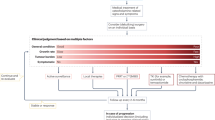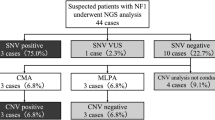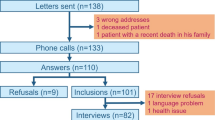Abstract
Familial paraganglioma is a dominantly inherited disorder characterised by the development of highly vascular tumours in the head and neck. Recently, a relationship between hereditary tumours derived from the autonomic nervous system and germline mutations in the gene encoding succinate dehydrogenase complex subunit D (SDHD) is increasingly a subject of study. Familial paraganglioma syndrome is embryologically related to phaeochromocytoma, another neuroendocrine tumour that shows great aetiological and genetic heterogeneity. Some hereditary phaeochromocytomas may be associated with germline mutations in VHL, RET and NF1 genes in genetic disorders such as von Hippel–Lindau disease (VHL), multiple endocrine neoplasia type 2 (MEN 2) and neurofibromatosis type 1 (NF 1), respectively. However, there are many cases that cannot be explained by mutations in these genes. In this report, we describe two previously unreported mutations in two patients from 25 unrelated kindreds with phaeochromocytoma and/or paraganglioma disorders and with or without familial antecedents: a mutation featuring the change of tryptophan to a termination codon in exon 2, and a 4-bp deletion in exon 4 that results in a truncated protein. We also describe one missense substitution of uncertain significance. The patients had previously tested negative for germline mutations in VHL and RET genes and had not been previously selected. The involvement of SDHD mutations in familial phaeochromocytoma and/or paraganglioma predisposition is of considerable interest since other studies have shown these alterations to be associated with highly expressed angiogenic factors.
Similar content being viewed by others
Log in or create a free account to read this content
Gain free access to this article, as well as selected content from this journal and more on nature.com
or
References
Koch CA, Vortmeyer AO, Huang SC, Alesci S, Zhuang Z, Pacak K . Genetic aspects of pheochromocytoma Endocr Regulations 2001 35: 43–52
Baysal BE, Ferrell RE, Willett-Brozick JE et al. Mutations in SDHD, a Mitochondrial Complex II Gene, in Hereditary Paraganglioma Science 2000 287: 848–851
Badenhop RF, Cherian S, Lord RS, Baysal BE, Taschner PE, Schofield PR . Novel mutations in the SDHD gene in pedigrees with familial carotid body paraganglioma and sensorineural hearing loss Genes Chromosomes Cancer 2001 3: 255–263
Masuoka J, Brandner S, Paulus W et al. Germline SDHD mutation in paraganglioma of the spinal cord Oncogene 2001 20: 5084–5086
Milunsky JM, Maher TA, Michels VV, Milunsky A . Novel mutations and the emergence of a common mutation in the SDHD gene causing familial paraganglioma Am J Med Genet 2001 100: 311–314
Taschner PE, Jansen JC, Baysal BE et al. Nearly all hereditary paragangliomas in the Netherlands are caused by two founder mutations in the SDHD gene Genes Chromosomes Cancer 2001 31: 274–281
Astuti D, Latif F, Dallol A, Dahia PL, Douglas F, George E, Skoldberg F, Husebye ES, Eng C, Maher ER . Gene mutations in the succinate dehydrogenase subunit SDHB cause susceptibility to familial pheochromocytoma and to familial paraganglioma Am J Hum Genet 2001 69: 49–54
Chandel NS, Maltepe E, Goldwasser E, Mathieu CE, Simon MC, Schumacker PT . Mitochondrial reactive oxygen species trigger hypoxia-induced transcription Proc Natl Acad Sci USA 1998 95: 11715–11720
Gimenez-Roqueplo AP, Favier J, Rustin P et al. The R22X mutation of the SDHD gene in hereditary paraganglioma abolishes the enzymatic activity of complex II in the mitochondrial respiratory chain and activates the hypoxia pathway Am J Hum Genet 2001 69: 1186–1197
Milunsky J, DeStefano AL, Huang XL et al. Familial paragangliomas: linkage to chromosome 11q23 and clinical implications Am J Med Genet 1997 72: 66–70
Anderson RJ, Lynch HT . Familial risk for neuroendocrine tumors Curr Opin Oncol 1993 5: 75–84
Schimke RN . Multiple endocrine neoplasia: how many syndromes? Am J Med Genet 1990 37: 375–383
Maher ER, Webster AR, Richards FM et al. Phenotypic expression in von Hippel-Lindau disease: correlations with germline VHL gene mutations J Med Genet 1996 33: 328–332
Aguiar RC, Cox G, Pomeroy SL, Dahia PL . Analysis of the SDHD gene, the susceptibility gene for familial paraganglioma syndrome (PGL1), in pheochromocytomas J Clin Endocrinol Metab 2001 86: 2890–2894
Gimm O, Armanios M, Dziema H, Neumann HP, Eng C . Somatic and occult germ-line mutations in SDHD, a mitochondrial complex II gene, in nonfamilial pheochromocytoma Cancer Res 2000 60: 6822–6825
Sambrook J, Fritsch EF, Maniatis T . Molecular Cloning: a Laboratory Manual 2nd edn Cold Spring Harbor, NY: Cold Spring Harbor Laboratory Press 1989
Orita M, Suzuki Y, Sekiya T, Hayashi K . Rapid and sensitive detection of point mutations and DNA polymorphisms using the polymerase chain reaction Genomics 1989 5: 874–879
Baysal BE, Willett-Brozick JE, Taschner PE, Dauwerse JG, Devilee P, Devlin B . A high-resolution integrated map spanning the SDHD gene at 11q23: a 1.1-Mb BAC contig, a partial transcript map and 15 new repeat polymorphisms in a tumour-suppressor region Eur J Hum Genet 2001 9: 121–129
Astuti D, Douglas F, Lennard TW et al. Germline SDHD mutation in familial phaeochromocytoma Lancet 2001 357: 1181–1182
Hirawake H, Taniwaki M, Tamura A, Kojima S, Kita K . Cytochrome b in human complex II (succinate-ubiquinone oxidoreductase): cDNA cloning of the components in liver mitochondria and chromosome assignment of the genes for the large (SDHC) and small (SDHD) subunits to 1q21 and 11q23 Cytogenet Cell Genet 1997 79: 132–138
Ackrell BAC . Progress in understanding structure-function relationships in respiratory chain complex II FEBS Lett 2000 466: 1–5
Shenoy SK, Yu L, Yu CA . The smallest membrane anchoring subunit (QPs3) of bovine heart mitochondrial succinate-ubiquinone reductase. Cloning, sequencing, topology, and Q-binding domain J Biol Chem 1997 272: 17867–17872
Towler DA, Gordon JI, Adams SP, Glaser L . The biology and enzymology of eukaryotic protein acylation Annu Rev Biochem 1988 57: 69–99
Yuasa H, Ito M, Oiso Y, Kurokawa M et al. Novel mutations in the V2 vasopressin receptor gene in two pedigrees with congenital nephrogenic diabetes insipidus J Clin Endocrinol Metab 1994 79: 361–365
Parfait B, Chretien D, Rotig A, Marsac C, Munnich A, Rustin P . Compound heterozygous mutations in the flavoprotein gene of the respiratory chain complex II in a patient with Leigh syndrome Hum Genet 2000 106: 236–243
Acknowledgements
We thank the patients participating in this study and the clinicians who provided blood samples and clinical information. We are also grateful for the technical assistance of Rocío Letón. This work was partially supported by the Fondo de Investigaciones Sanitarias project FIS 00/0118. Alberto Cascón is a postdoctoral fellow of the Excmo. Ayuntamiento de Madrid.
Author information
Authors and Affiliations
Corresponding author
Rights and permissions
About this article
Cite this article
Cascon, A., Ruiz-Llorente, S., Cebrian, A. et al. Identification of novel SDHD mutations in patients with phaeochromocytoma and/or paraganglioma. Eur J Hum Genet 10, 457–461 (2002). https://doi.org/10.1038/sj.ejhg.5200829
Received:
Revised:
Accepted:
Published:
Issue date:
DOI: https://doi.org/10.1038/sj.ejhg.5200829
Keywords
This article is cited by
-
A need to tailor surveillance based on family history: describing a highly penetrant familial paraganglioma kindred with an SDHD pathogenic variant
Familial Cancer (2023)
-
Pathological mechanisms and parent-of-origin effects in hereditary paraganglioma/pheochromocytoma (PGL/PCC)
neurogenetics (2011)
-
LOH on chromosome 11q, but not SDHD and men1 mutations was frequently detectable in chinese patients with pheochromocytoma and paraganglioma
Endocrine (2006)
-
The SDH mutation database: an online resource for succinate dehydrogenase sequence variants involved in pheochromocytoma, paraganglioma and mitochondrial complex II deficiency
BMC Medical Genetics (2005)
-
Mutations of the SDHB and SDHD genes
Familial Cancer (2005)



